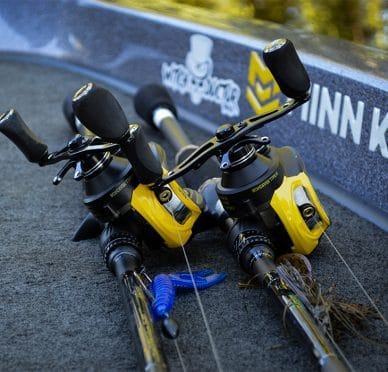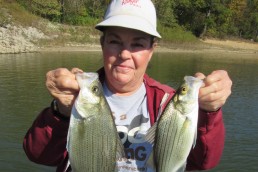Fall Turnover…What is it? Where is it? Fishing it!
SHARE THIS POST
For us anglers in the Midwest, the term fall turnover brings about several thoughts and questions. What exactly does fall turnover mean? What happens when a lake turns over is that the lower layer of the lake mixes quickly with the upper layer of the lake.
Locals or regulars to a certain lake will develop their own opinions on what happens during the turnover. Many times, they’ll blame tough fishing conditions or fish kills on the turnover. What researchers have discovered is that, yes, bass are affected by the turnover, some more than others, but typically only for a few days. The bass that spend the majority of their year in deep water and only go shallow to spawn in the spring will be affected the most.
Big bodies of water that have current, either from a river or wind, will rarely experience a fall turnover. If it does occur, the impact on bass will be minimal to non-existent. This is because the water is being stirred up all season long, resulting in the lake’s water being very similar across all depths.
If the body of water you are fishing does experience a fall turnover and the fishing does just seem “off,” the easiest thing to do is come back in a few days and it will be back to normal. As fishermen, we all know that fishing is fishing!
If you are hitting a lake that is in the process of a turnover or just has gone through it, be thinking about the bass you caught deep during the summer months. Those bass were positioned near the thermocline. The turnover has now eliminated that, so bass have no restraints on where they can go. They may be deeper than they were during the summer, or they may have pushed up shallow with the population of bass that live up there all season long.
Keeping a keen eye to the water you are fishing will aid in you visually being able to identify that the fall turnover has occurred or is happening. If you notice that the water clarity has suddenly decreased dramatically and there are clumps of dead or dying vegetation on the water’s surface, then you know turnover has happened.
You can also identify that the turnover has happened by using your electronics. I’ll turn the sensitivity on my Humminbird SOLIX unit way up and idle around in deep water. If I see baitfish scattered across all depths, I’ll know that lake is in turnover mode.
Being that the bass are now “free range,” you’ll want to rely on presentations that allow you to cover the greatest amount of water possible. Three great presentations to accomplish this include:
Spinnerbaits
This is a very popular fall lure as it can be cast far, retrieved at various speeds and depths and the changing up of blade combinations make this lure extremely versatile.
Tip: I like to keep extra spinnerbait blades, swivels, clevis and beads in a Lure Lock LL3 case so I can alter my spinnerbaits based on the conditions I’m fishing. With the ElasTak GEL in the Lure Lock cases, I don’t have to worry about all those small items moving around.
Are you enjoying this post?
You can be among the first to get the latest info on where to go, what to use and how to use it!
Lure choice: A War Eagle Screaming Eagle spinnerbait is my top choice. It weighs half an ounce, but is on the frame of a 3/8-ounce spinnerbait. This allows me to burn the bait with ease.
Swim jigs
Fishing a 1/4- or 3/8-ounce swim jig is a great technique to use if you are covering water that is 6 feet or less and there are still some clumps of vegetation or you are fishing around vegetation in shallow water that is still present.
Tip: Switch up the trailer on your swim jig if the bass are short striking. I’ll commonly go from a Zoom UV Speed Craw to a Super Speed Craw as the bulk gives the bass a bigger profile to key in on.
Crankbaits
Another great lure choice that helps you cover water quickly to locate schooled up fall bass. Selecting a crankbait that will just come in contact with any remaining vegetation is key.
Tip: Switching up your line size will affect the depth at which your crankbait runs. If you want to get your crankbait to run deeper, decrease the pound test. Likewise, if you want the bait to run shallower, increase the pound test. For me, I’ll begin with 15-pound Seaguar Inviz X Fluorocarbon and then increase or decrease the pound test as needed.
Lure choice: For me, the Rapala DT series of crankbaits is hard to beat. You can select a bait that has the diving depth and size profile based on the conditions you are facing and they have a nice action in the cooler water.
Jig
It is hard to beat a jig when you are fishing the remaining, isolated weed clumps in a lake, or you have it ready to flip up shallow for any hard cover you may come across, such as a laydown or remaining boat dock.
Lure choice: An All-Terrain Tackle 1/2-ounce AT Jig in black/blue with a Zoom Super Chunk or Z-Craw Jr. allows me to fish at any depth and work my jig fast or slow, depending on what the bass want that day.
By taking a look at my ScoutLook Fishing App, I’m able to garner a key piece of information that is critical when fishing this time of year, wind direction. This way, I can fish the side of the lake that has the wind blowing warmer water into, or has the wind blowing the dirty water out of it. This will either have the bass feeding due to the wind activity or feeding because of the cleaner water clarity.
Don’t be afraid if your favorite lake has turned over or is in the process of turning over. Bass still have to eat. If the fall weather is good, you might as well feed ‘em your favorite lure!
MWO
SHARE THIS POST
Did you enjoy this post?
You can be among the first to get the latest info on where to go, what to use and how to use it!
Glenn Walker
Glenn Walker has been fishing Minnesota and Mississippi River tournaments for more than 15 years, spreading his passion and knowledge of the sport via articles and videos. For more information, check out glennwalkerfishing.com or on Facebook @GlennWalkerFishing.



